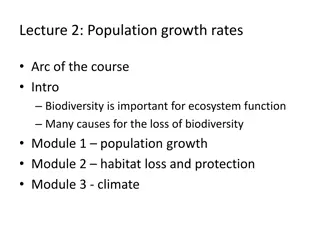Government Initiatives and Impact on Biodiversity Conservation in India
India, a mega-diverse country, has taken significant steps to protect biodiversity through various initiatives and laws. The government has established protected areas, enacted the Wildlife Protection Act, and set up the Wildlife Crime Control Bureau. Research organizations like the Wildlife Institute of India work towards wildlife conservation, while policies and acts focus on environmental protection and biodiversity conservation.
- Biodiversity Conservation
- Indian Government
- Wildlife Protection
- Environmental Policies
- Research Organizations
Download Presentation

Please find below an Image/Link to download the presentation.
The content on the website is provided AS IS for your information and personal use only. It may not be sold, licensed, or shared on other websites without obtaining consent from the author. Download presentation by click this link. If you encounter any issues during the download, it is possible that the publisher has removed the file from their server.
E N D
Presentation Transcript
DEVELOPMENTAL PROJECTS INCLUDING GOVERNMENT INITIATIVES AND THEIR IMPACT ON BIODIVERSITY CONSERVATION
Biodiversity protection: Steps taken by Biodiversity protection: Steps taken by Indian Government Indian Government India is a signatory to several major international conventions relating to conservation and management of wildlife. Some of these are convention on biological diversity, Convention on International Trade in Endangered Species of Wild Fauna and Flora (CITES), convention on the conservation of migratory species of wild animals etc. Financial and technical assistance is provided to state/union territory governments for protection and management of protected areas as well as other forests under various centrally sponsored schemes
Continued India is one among the 17 mega-diverse countries of the world. But many plants and animals are facing the threat of extinction. To protect the critically endangered and other threatened animal and plant species, government of India has adopted many steps, laws and policy initiatives.
Steps Taken By Government for Steps Taken By Government for Biodiversity Protection Biodiversity Protection Indian government has taken various biodiversity protection steps. Important measures include: The central government has enacted the wild life (protection) Act, 1972. The Act, provides for the creation of protected areas for the protection of wildlife and also provides for punishment for hunting of specified fauna specified in the schedules I to IV thereof. Wetland (conservation and management) rules 2010 have been framed for the protection of wetlands in the states. National plan for conservation of Aquatic eco-system. Wildlife crime control bureau has been established for control of illegal trade in wildlife, including endangered species.
Wildlife institute of India, Bombay natural history society and Salim Ali centre for ornithology(The branch of zoology that studies birds) and natural history are some of the research organization undertaking research on conservation of wildlife. The centrally sponsored scheme Integrated development of wildlife Habitats has been modified by including a new component namely Recovery of Endangered Species . Protected Areas, viz, National parks, sanctuaries, conservation reserves and community reserves all over the country covering the important habitats have been created as per the provision of the wild life protection act, 1972. The central bureau of investigation (CBI) HAS EMPOWERED UNDER THE WILD LIFE (protection) Act, 1972 to apprehend and prosecute wildlife offenders.
Important Indian Acts passed related to Environment and Bio- diversity. Policies related to environment and biodiversity:- 1) National forest policy National conservation strategy and policy statement on environment and development National Policy and macro-level action strategy on biodiversity. National biodiversity action plan (2009) National agriculture policy National water policy National environmental policy (2006).
Projects save threatened species Projects save threatened species Project Tiger: Project Tiger: Project tiger was initiated as a central sector scheme in 1973 with 9 tiger reserves located in different habitat types in 9 different states. There are totally 18 reserves in 13 states. At present tiger conservation has been viewed in India not only as an effort to save an endangered species but, with equal importance. Crocodile breeding project: Crocodile breeding project: The project was started in Orissa and then extended to several other states in April 1975 with UNDP assistance. The main objective was to protected the three endangered species of crocodiles.
Continued Lesser Cats project: Lesser Cats project: The project was launched in 1976 with the assistance of WWF in India for conservation of four species of lesser cats, found in Sikkim and Northern part of West Bengal. The Manipur Brow The Manipur Brow- -antlered deer Project: antlered deer Project:- - This project was launched in 1981 in Manipur to save the brow-antlered deer, which is on the verge of extinction. Project Elephant: Project Elephant:- - It was launched in 1991 to protect the Asiatic elephant which is also a highly endangered species because of large scale poaching. Project Rhino: Project Rhino: It was launched in 1987 in Kaziranga wildlife sanctuary in Assam to save the lesser one horned Rhino from extinction.
Himalayan musk deer project Himalayan musk deer project: This was launched in 1981 to save the endangered musk deer which is facing extinction. Project Hangul: Project Hangul: This project was launched in 1970 in Kashmir valley to save the highly endangered Kashmir stag (Cerevus elaphus hanglu)

























